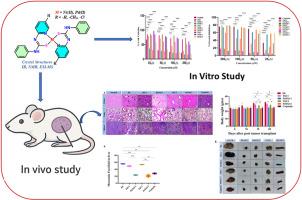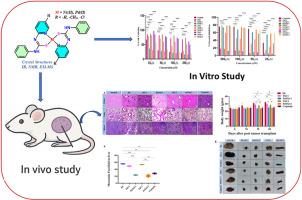基于一系列硫脲基配体的Ni(II)和Pd(II)配合物抗肿瘤潜能的体内外研究
IF 5.9
2区 医学
Q1 CHEMISTRY, MEDICINAL
引用次数: 0
摘要
钯(II)配合物已被研究作为癌症治疗的前瞻性化疗药物。本研究旨在合成并表征三种不同取代基的硫脲基配体(-H (ThU1), -Cl (ThU2), -CH3 (ThU3))及其相应的Ni(II)和Pd(II)配合物。通过FT-IR、NMR、ESI-MS和SC-XRD对合成的配体和金属配合物进行了表征。PdThU1和PdThU2的SC-XRD分析证实了钯中心周围的方形平面几何形状。配体和金属配合物对转移性和高侵袭性转移性小鼠淋巴瘤(DL)和人B细胞淋巴瘤(Raji)癌细胞的体外抗增殖活性表明,Pd(II)配合物比硫脲配体和Ni(II)配合物具有更好的细胞毒性反应。有趣的是,Pd(II)配合物PdThU1 (2.45 μM & 5.19 μM)和PdThU2 (4.7 μM & 9.54 μM)对DL和Raji癌细胞的IC50值分别低于顺铂(34.96 & 71.13 μM)。进一步,用LDH释放法研究其直接细胞毒性。PdThU1和PdThU2对正常人淋巴细胞和单核细胞的细胞活力分析表明它们具有生物相容性。采用Annexin V-FITC/PI标记和流式细胞术评估细胞凋亡诱导。在BALB/c小鼠DL肿瘤模型上进行了体内研究,以评估治疗效果和生物安全性。体内研究表明,PdThU1和PdThU2显著降低肿瘤生长,延长生存期,毒性最小。我们的数据表明,Pd(II)复合物在体外和体内对小鼠淋巴瘤都有明显的抗肿瘤作用。本文章由计算机程序翻译,如有差异,请以英文原文为准。


In vitro and in vivo studies on antitumor potential of Ni(II) and Pd(II) complexes based on a series of thiourea-based ligands
Palladium (II) complexes have been investigated as prospective chemotherapeutic agents for cancer treatment. This study aims to synthesize and characterize three thiourea-based ligands with different substituents (-H (ThU1), -Cl (ThU2), –CH3 (ThU3)) and their corresponding Ni(II) and Pd(II) complexes. The synthesized ligands and metal complexes are well characterized by FT-IR, NMR, ESI-MS, and SC-XRD studies. SC-XRD analysis of PdThU1 and PdThU2 confirmed square planar geometries around the palladium centre. The in-vitro antiproliferative activities of ligands and metal complexes against a metastatic and highly aggressive metastatic murine lymphoma (DL) and human B cell lymphoma (Raji) cancer cells suggest Pd(II) complexes have a much better cytotoxic response than thiourea ligands and Ni(II) complexes. Interestingly, Pd(II) complexes PdThU1 (2.45 μM & 5.19 μM) and PdThU2 (4.7 μM & 9.54 μM) showed significantly lower IC50 values compared to cisplatin (34.96 & 71.13 μM) against DL and Raji cancer cells, respectively. Further, direct cytotoxicity was studied using LDH release assay. The cell vialibity analysis of PdThU1 and PdThU2 against normal human lymphocytes and monocytes suggests their biocompatibility. Apoptosis induction was assessed using Annexin V-FITC/PI labelling and flow cytometry. In vivo investigations were performed on a BALB/c mouse DL tumour model to assess treatment effectiveness and biosafety. In vivo studies demonstrated that PdThU1 and PdThU2 significantly reduced tumour growth and prolonged survival, with minimal toxicity. Our data suggests that the Pd(II) complexes demonstrated significant antitumor effect against murine lymphoma both in vitro and in vivo.
求助全文
通过发布文献求助,成功后即可免费获取论文全文。
去求助
来源期刊
CiteScore
11.70
自引率
9.00%
发文量
863
审稿时长
29 days
期刊介绍:
The European Journal of Medicinal Chemistry is a global journal that publishes studies on all aspects of medicinal chemistry. It provides a medium for publication of original papers and also welcomes critical review papers.
A typical paper would report on the organic synthesis, characterization and pharmacological evaluation of compounds. Other topics of interest are drug design, QSAR, molecular modeling, drug-receptor interactions, molecular aspects of drug metabolism, prodrug synthesis and drug targeting. The journal expects manuscripts to present the rational for a study, provide insight into the design of compounds or understanding of mechanism, or clarify the targets.

 求助内容:
求助内容: 应助结果提醒方式:
应助结果提醒方式:


